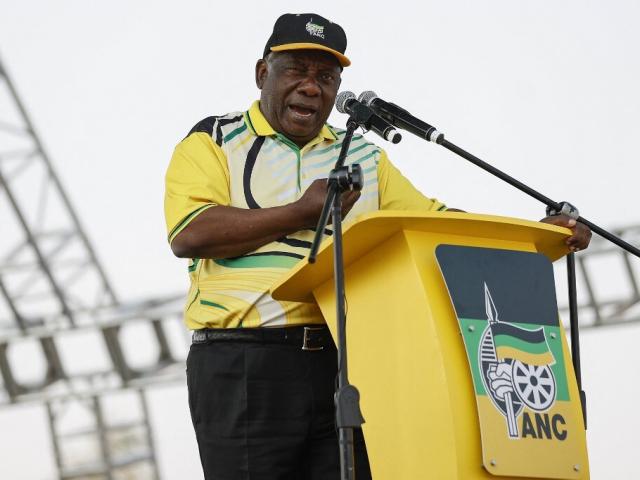-
President Cyril Ramaphosa was most on the money when it came to claims about education, access to basic services and health markers in South Africa.
-
Literacy rates have improved significantly since 1994, more than 85% of households access water and electricity, the government’s antiretroviral treatment programme is impressive and the incidence of tuberculosis is decreasing.
-
However, the ANC understated the number of South Africans employed in 1994, inflating the growth in employment over 30 years, and was unclear on the number of free “houses” provided and how many of these were women-owned.
The city of Mbombela in South Africa’s Mpumalanga province was the location for this year’s African National Congress (ANC) January 8th statement.
The annual event marks the anniversary of the country’s ruling party, which turned 112 in 2024.
“We are here to celebrate our past, to chart the future and outline the tasks for the period ahead,” president Cyril Ramaphosa told the crowds gathered at Mbombela Stadium.
Mindful of “complex moments” both at home and globally, Ramaphosa spoke of the significant improvements that had taken place in South Africa over the last 30 years, made possible by his party.
“There are those who say nothing has changed, but they also know that they are not telling the truth.”
To support his argument, Ramaphosa made several claims, which we’ve fact-checked in this report.
Women should be represented in all public institutions, Ramaphosa said, before claiming that almost half of the seats in parliament were held by women.
This is true for the national assembly. According to data from the Inter-Parliamentary Union (IPU), an organisation that represents several international parliaments, 45.8% of the 400 seats in South Africa’s parliament are held by women.
One of the ANC’s greatest achievements, Ramaphosa said, was the expansion of basic services and infrastructure.
Using housing as an example, Ramaphosa said: “I know of no country – certainly on our continent, and in other continents as well – that has built houses, 4.7 million, and given them to our people mahala.”
“Mahala” is Southern Sesotho for “free”.
Listeners would be forgiven for thinking that “4.7 million houses” meant physical buildings.
With this claim, Ramaphosa appears to have deviated from the version of his speech published on the ANC website, which said that “through the provision of houses, subsidies and serviced sites, government has managed to provide 4.7 million homes”.
But we can only fact-check what he said, and not what he intended to say.
It is correct that the Department of Human Settlements (DHS) has provided about 4.8 million “housing opportunities” since 1994. But a “housing opportunity” is not the same as a “house”.
“Housing opportunities” include several categories of government housing which range from newly constructed housing to bare plots of land which have only been connected to utilities, such as water, electricity, and sewage.
In 2019, the DHS provided Africa Check with a complete breakdown of the number of housing opportunities it had delivered up to December 2018. Manually adding the numbers of newly built houses listed in each of the department’s annual reports published since then, we counted a total of 3,459,965 newly built houses.
We therefore rate this claim as misleading. At Africa Check we apply this rating when elements of the claim are accurate but presented in a way that it is misleading.
Fébé Potgieter, head of policy and research at the ANC, told Africa Check that the source of this data was the DHS, which “keeps a database of all beneficiaries of government housing subsidies, broken down by gender”. She provided a photograph of a portion of a spreadsheet, which lists female “total approved beneficiaries” by province. The figures add up to 1,917,851.
It is not clear from the photograph exactly what categories of state-provided housing are included in this count. But Potgieter said that the DHS database “includes breaking new ground housing subsidies (RDP) and FLISP subsidies”.
Breaking new ground houses, formerly known as reconstruction and development programme (RDP) houses, are newly built houses. The “First Home Finance” programme, previously known as the “Finance Linked Individual Subsidy Programme” (FLISP), assists recipients with loans for buying houses, apartments and serviced sites, or for building homes on already purchased sites.
Potgieter also pointed Africa Check to an article on state-subsidised housing which used data collected by Lightstone Property, a data and analytics firm. Lightstone data indicated that 1.05 million women were single owners of breaking new ground housing, and 600,000 more were joint owners with another person. This means 1.65 million women were the owners of newly built houses.
Presumably, the remainder is made up of women who received housing subsidies, but this is difficult to verify from the photo we were sent. We have reached out to Lightstone Property and the DHS for clarity. Until then, we rate the claim unproven. In other words, publicly available information neither proves nor disproves this claim.
Update: While originally rated unproven, the DHS confirmed that the figures shared by the ANC were accurate and based on thorough verification, including visiting beneficiaries in person. Of the 2,039,859 beneficiaries to have received actual houses, 1,917,851 were women (some of whom may own a house jointly with someone else).
Statistics South Africa (Stats SA), the country’s data agency, tracks households’ access to basic services every two years in its general household survey (GHS). The latest survey covers 2022 and supports Ramaphosa’s claim.
Just under 89% of households reported having access to piped water, including inside their dwelling or yard, or outside the yard, for example from neighbours’ or communal taps. When looking only at piped water access inside a household’s dwelling or yard, this number drops to 75.8% in the GHS.
The 2022 national census also contains estimates for water access. It reported that 91.3% of households had access to piped water (of any type), and 82.4% to piped water inside the dwelling or yard.
Africa Check spoke with Niël Roux, Stats SA’s director of service delivery statistics, about the differences in the census and GHS figures. He said that while the GHS is vital to tracking trends over time, “census figures should generally be considered more accurate” because of their larger sample size. Where the GHS surveyed tens of thousands of households, the census surveyed millions.
But there were also other possible reasons for the different figures, Roux said. For instance, there were slight differences in how the questions were formatted in the GHS and the census. And while the census collected data from February 2022, the GHS was from July of that year. But, Roux said, the impact of this date difference would be very small.
Whatever estimates are used, the quality of water in the country’s supply systems is an issue. According to a recent assessment by the water department, almost half (46%) of South Africa’s water supply systems “achieved poor or bad quality” compliance with standards set out for safe, clean drinking water.
In comparison, in 2014 only 5% of systems were given this status. The Department of Water and Sanitation said this indicated “a severe regression in drinking water quality between 2014 and 2023”.
The 2022 GHS reported that 89.6% of households surveyed had access to mains electricity, referring to electricity provided by a municipality or Eskom, the state-owned energy company. In 2002, when the first GHS survey was conducted, the figure stood at 76.7%.
Ramaphosa missed an opportunity to claim a higher figure.
It is worth mentioning that while access to electricity has improved, planned electricity outages, or load shedding, affected supply on 335 days in 2023 and 15 days in 2024 at time of publication.
While exact numbers vary, experts agree that load shedding severely impacts the South African economy.
In addition to housing, the ANC-led government had dramatically improved access to education, Ramaphosa said, from early childhood right through to post-school education: “Nearly every young person aged 15 to 24 years is literate.”
Stats SA bases an individual’s functional literacy on whether they have completed at least grade 7.
According to a factsheet published by the higher education department in March 2022, and using 2020 data from Stats SA, the percentage of people aged between 15 and 24 who had not completed grade 7 was 7.1%.
Ramaphosa’s claim is therefore correct.
According to Stats SA, improved access to schooling has led to a significant decline in the percentage of functionally illiterate individuals in the 20 to 39 age group. In 2002, this figure stood at 32.9%. In 2022, it was 7.1%.
Measuring literacy in line with international standards
A simple definition of literacy is the ability to read and write in at least one language. But the United Nations Educational, Scientific and Cultural Organization (Unesco) defines literacy as “the ability to identify, understand, interpret, create, communicate, compute and use printed and written materials”.
This type of literacy is typically measured using the developmental outcomes expected from certain grades in school. Internationally, students in grade 4 are expected to be able to read for meaning. That is, they should be able to read, process, contextualise, and understand the message of a text.
South African students tend to underperform in international benchmark tests, such as the Progress in Reading Literacy Study, when examined in grade 4. The Department of Higher Education and Training (DHET) cites this as one of the reasons why it uses grade 7 as its measure of literacy.
Keeping with the theme of education, Ramaphosa next spoke about adult literacy.
Over the years, government interventions such as adult basic education training (ABET) and the Kha Ri Gude literacy campaign have been introduced to improve adult literacy levels.
The DHET defines adults as people aged 20 and older. Adults are considered functionally literate if they have completed grade 7 (or the equivalent ABET level 3).
According to Stats SA’s latest GHS, adult literacy stood at 89% in 2022. Ramaphosa missed the opportunity to claim a larger percentage.
Stats SA’s 1996 general census had data on the number of adults who had completed primary school. The figure was 63.9%, making Ramaphosa’s claim correct.
Antiretroviral therapy, or ART, is a treatment programme for the human immunodeficiency virus, or HIV.
While there is currently no cure for HIV, ART can reduce the level of the virus in a person’s blood to a point where it becomes undetectable, untransmittable, and does not progress to the deadly acquired immunodeficiency syndrome, or Aids.
Former South African president Thabo Mbeki controversially delayed the provision of ART in South Africa, significantly worsening the country’s HIV/Aids epidemic.
However, since the widespread rollout of ART began in 2004, Aids-related deaths have fallen dramatically, and South Africa now has an expansive and effective HIV treatment programme, which provides care to millions of people. But how many exactly?
The health department said in its 2022/23 annual report that there were 5,453,928 patients “on antiretroviral therapy remaining in care” under its district health programme grant. This grant funds the government’s ART programme, but it does not include some ART patients, such as those who receive ART through the private sector.
The health department does not report the total number of ART patients, but fortunately, very accurate estimates do exist.
The Thembisa model is a robust estimate of HIV-related figures. The Joint UN Programme on HIV and Aids has used it as their official source for South Africa since 2017. It estimated that between 5.8 and 5.9 million people were receiving ART in 2023. In comparison, the model estimates that there are around 7.9 million people with HIV in South Africa.
The model is very reliable. It is regularly adjusted to match newly released data, including from the private sector, to ensure that it is accurately representative of all ART patients.
Tuberculosis, or TB, is a bacterial disease which kills millions of people worldwide each year. It was the second leading cause of death in 2022, after Covid-19.
TB affects the lungs and is of particular concern in South Africa because it is especially dangerous to people with HIV and other diseases that weaken the immune system.
According to data collected by South Africa’s National Institute for Communicable Diseases, the incidence of TB – that is, the proportion of the population with the disease – fell from 738 confirmed cases per 100,000 people in 2011, to 92 in 2022. The only year in which this incidence rose, was 2021, when it peaked above the 2020 figure.
Unconfirmed case numbers may be much higher. South Africa’s first National TB Prevalence Survey estimated an incidence of around 852 cases per 100,000 people in 2018. But the trend is still encouraging.
Data from the World Health Organization indicates that South Africa’s TB incidence is not only falling but that it is one of only six others among 30 “high TB burden countries” to meet the 2020 goal of the organisation’s End TB Strategy.
According to findings from the October Household Survey (OHS), Stats SA estimated that a total of 8.9 million people were employed in 1994.
The OHS was conducted annually until 1999 when it was replaced by the Labour Force Survey. Though the 1994 OHS comprised too few black respondents to be fully representative, it was considered a “benchmark … in information gathering”, surveying 30,000 households and for the first time including the nominally independent black “homelands” or Bantustans in country statistics.
By claiming a lower figure, Ramaphosa has exaggerated the progress made since 1994.
The latest data, available in Stats SA’s Quarterly Labour Force Survey, showed that between July and September 2023, 16.745 million people were employed.
But comparing this with historical figures is not straightforward. Africa Check spoke with Dr Neva Makgetla, senior economist at the Trade and Industrial Policy Strategies research institute, who said that looking only at these raw numbers was problematic.
While the raw number of employed people has increased, so has the working-age population (ages 15 to 64), from 24.6 million in 1994 to 40.9 million today. A more accurate way to look at the situation, Makgetla said, was as a ratio of those employed compared to the working-age population. The ratio stood at 41% in 2023, which was approximately the same as in 1994, Makgetla told us.
Moreover, the expanded unemployment rate, including discouraged work-seekers or others who did not seek work, was reported as 35% in 1994, and it was higher in 2023, at 41.2%.
And this isn’t the only problem. According to Makgetla, the earlier employment data was generally less reliable. As some researchers note, the different methods and kinds of data used in calculations for the October Household Survey and subsequent labour force surveys mean the results of these studies may not even be comparable to each other.
We therefore rate this claim misleading.
The growth of a country’s economy is often measured in terms of gross domestic product (GDP), the sum of all the goods and services produced in the country in a given year.
As the World Bank explains, GDP is reported in current (nominal) and constant (real) prices. Constant GDP accounts for the effects of inflation, and so can measure “real” economic growth.
South Africa’s real GDP was US$360.7 billion in 2022, according to the World Bank. In 1994, real GDP stood at $187.4 billion. Overall, real GDP has seen an upward trend, with mostly steady increases over the last 30 years, except for dips during the global recession in 2008 and at the start of the Covid-19 pandemic in 2020.
Prof Jannie Rossouw from the Wits Business School at the University of the Witwatersrand in Johannesburg told Africa Check that other indicators painted a less rosy picture.
Per capita GDP, for instance, had not fared as well, Rossouw said. This measures a country's economic output per person.
Despite an overall increase since 1994, GDP per capita has not shown consistent improvements over the last 15 years. Data from the World Bank suggests that by this indicator, the economy has yet to fully recover from successive dips following the global recession and then the Covid-19 pandemic.
GDP per capita was $6,022 in 2022, less than it was in 2008, when the figure was $6,074. And the country’s economy, Rossouw said, had slipped relative to other countries. Organisations such as the International Monetary Fund, the World Bank and the African Development Bank have outlined some of the specific challenges faced by the South African economy. According to Harvard University, these include collapsing state capacity and spatial exclusion.








Add new comment